#barnor hesse
Text
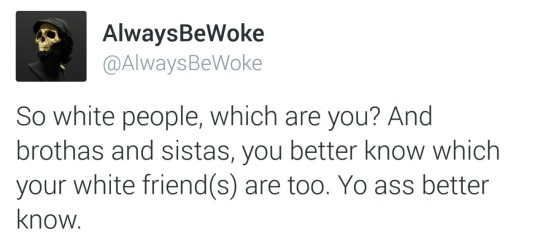
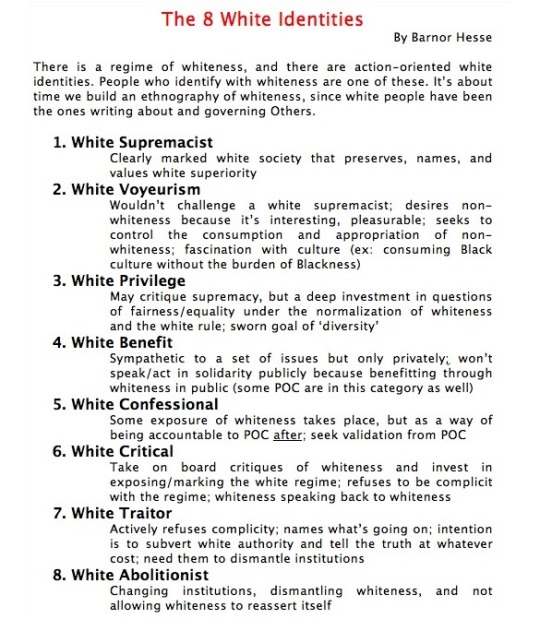
So, IDGAF about none of these Crackas.
And, I don't beg no whitey mon fi bloodclot friend.
Far as I'm concerned, all of these are the same, & they each change faces like a Quintesson.
Dismantling white institutions is an illusion. NONE of them have ever done it. If so, why do they still exist.
Barnor Hesse is just a goofy Negropean that wants to love Crackas soooo bad. I really wouldn't be surprised if he has a white spouse. 🤷🏿♂️
5 notes
·
View notes
Text

#barnor hesse#8 white identities#support blm#support bipoc#black girl cottagecore#black girl magic#black boy joy#black history month#black history matters#white trader#let’s get liberated#be the change#slow factory foundation#rabbit rabbit#evergreen post
1K notes
·
View notes
Photo
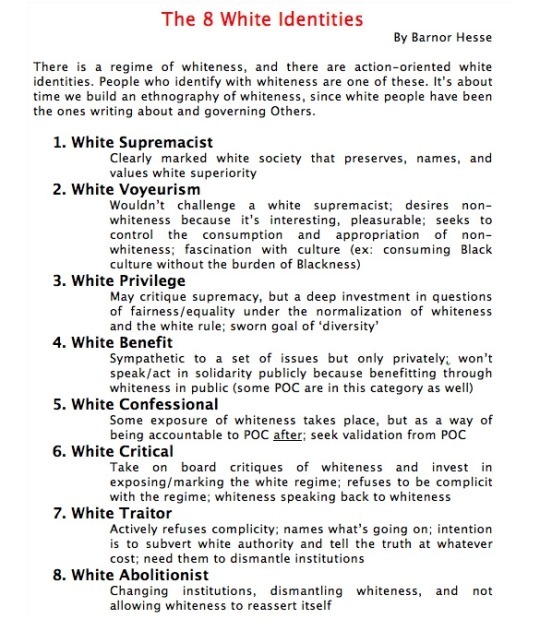
. I hope that white people read this list and do some serious and honest self-reflection and self-assessment. .
29 notes
·
View notes
Note
what are your criticisms of privilege theory?
fuzzy. misplace of focus. excites the wrong moods in the listener. and lacks explanatory power for the most pressing questions. in order,
it's fuzzy when it fails to distinguish abstract from particular. you'll say this: all white people benefit from white supremacy. back when these apologetics were common you'd put a lot of emphasis on the all, the way all of us are equally implicated and therefore bear a like responsibility. but the other guy will say, how do all white people benefit from white supremacy? and you'll start to talk about odds and averages, about 16th century legal codes (and their vague legacy), and so on, and you're still hovering around in the abstract, the disparity between how likely you are to encounter some kind of event, for example, incarceration, or about general features of society, like certain laws, which may never come up for an individual person. so you're staying on this level of abstract reason and you can't explain why those statistical regularities matter, what conditions white people's actions qua their whiteness, or even, how any given situation in a white person's life can be explained by their whiteness. the invisible knapsack can never be opened and its contents can never be examined. this is an old problem. [the following anecdote is so misremembered it might as well be a parable i came up with; i correct myself here] there's this recording of a 'struggle session' with the Black Panthers and a group of white American organizers, as i remember from poor rural backgrounds, and an argument breaks out between one Panther and one of the white men when the Panther remarks that the police 'exist to protect you' (or something similar), and the white man gets offended and says they sure aren't protecting him, because he's out there getting beaten by them and so on. the Panther is speaking abstractly, about an abstract white man, and this white man is talking about his own experience as a particular white man, so they will always talk past one another and that's what they did the rest of the session.
i am still 'on' this problem. you know how it is with me; i was tormented enough by internet arguments ten years ago to turn them into lifelong research priorities. early last year i made the above argument at length (in a long, demented, unpublished response to another anon, which was supposed to gradually transform into t4t smut, but it was abandoned in the second act due to theroetical blunders). i attempted to make my own account in 2019 here (pg 6-13; a similarly long, rambunctuous and abandoned piece of writing), engaing mainly with Maria Lugones, Nick Land and Achille Mbembe. since then i’ve read a lot of Marx and a bit of Hegel and now when i talk about it i tend to go on and on about ‘reflection’ and ‘grounding’ (eg. last december’s futapost, pg 2). i’m currently reading that book on the early modern causation debate for related reasons. something that was an influence on me was the discussion in Barnor Hesse’s preface to Conceptual Aphasia in Black (2016) about Alain Locke’s definition of race as a “social inheritance.”
it has a misplace of focus because it starts by trying to explain the benefits a white, male or cis subject can count on, which limits its scope to directly productive relations of exploitation, which in many cases either don’t exist or are not central to the oppressive relations under discussion. i make this point at length in this early 2021 post with respect to transmisogyny. Wilderson makes the point with respect to antiblackness in Gramsci’s Black Marx (2003). but so does Frére Dupont, Giorgio Agamben, Moishe Postone, Orlando Patterson, Jean Baudrillard, Michel Foucault, Gilles Deleuze & Felix Guattari, Jacques Camatte, Georges Bataille . . . in other words, privilege theory can’t interact with very much serious work on oppression and marginalization because they usually will proceed from an incompatible premise, that being, not all coercive social relations worth talking about are directly productive ones. a lot of the time privilege theory will count as privileges things like ‘i will never be followed around in a grocery store by a white person who thinks i’m going to shoplift’ (hastening to add for being black incase it does happen for some contingent reason, like being a stranger in a small-minded one horse town, which is ofcourse concretely possible if abstractly unlikely), such that a privilege can amount to a privation of oppression, which is an extremely unusual way to talk about any subject and is obviously an artefact of having an inexact premise.
it excites the wrong moods in the listener because it makes them feel ashamed, defensive, apologetic, self-conscious, ultimately self-centered and narcissistic, and it rewards race faking. your intersubjective task is to escape self-alienating consciousness, and, failing that, comfort, empower, inspire and mobilize. you should proceed from the knowledge that all men are ruled by rackets, “the rackets of clerics, of the royal court, of the propertied, of the race, of men, of adults, of families, of the police, of crime” (Max Horkheimer, Die Rackets und der Geist), and as a revolutionary your task is to make them feel safe, comfortable and articulate enough to escape theirs. to move their insular, sectional, beseiged subjectivity to something intersectoral, intersectional, and autonomous. no one needs to learn to sit down and listen, but to stand up and shout.
and finally it lacks explanatory power for the most pressing questions. that is to say, it cannot tell you what to do when your beloved comrades in the army of the oppressed defect to the Portugese side in exchange for promises of wealth and property, as did Amilcar Cabral’s, before he was assassinated and the revolution in Guinea defeated.
272 notes
·
View notes
Link
New York’s East Side Community School recently sent a letter encouraging white parents to become “white traitors” and advocate for “white abolition.”
The message, sent by principal Mark Federman, showed a graphic outlining eight stages of white identity development—from the lowest form, “white supremacist,” to the intermediate forms of “white confessional” and “white traitor,” to the highest form, “white abolitionist.” The goal of this process, according to the graphic’s creator, Northwestern University professor Barnor Hesse, is to challenge the “regime of whiteness” and eventually to “subvert white authority” and “not [allow] whiteness to reassert itself.”
…
The language in Federman’s letter carries disturbing historical echoes. The Ku Klux Klan and neo-Nazis used the term “race traitor” to describe whites who crossed the color line to work, marry, or associate with nonwhites. The letter’s use of “white abolition” is also troubling. Federman and Hesse claim to want to abolish “whiteness” as a cultural and social construct, but they also use the term to describe an immutable racial essence. As University of New Mexico professor Geoffrey Miller has observed: “Applied to any other group, this would sound like a monstrous euphemism for mass extermination and cultural annihilation.”
…
After I broke the news about these “white traitor” materials on social media, Federman sent another letter to parents. “I want to make it clear that I do not believe I did anything wrong,” he wrote in a schoolwide email, as the story quickly spread to the New York Post, Daily Mail, and other outlets. Federman then instructed school families not to speak to media. “Please do not reply to anyone. We do not want to encourage or engage these people. If anyone does email you, please share it with me,” he said.
“I was appalled” by the most recent messages about white abolition, said the parent whose children formerly attended the East Side Community School. Many school families share this opinion, according to this parent, but are “afraid to come forward” out of worry that they might be denounced as racists. The parent’s advice was simple: “We need to stop indoctrinating our youth and radicalizing them.”
Given the rise of critical race theory in public schools, this is easier said than done.
The graphic:

2 notes
·
View notes
Link
New York’s East Side Community School recently sent a letter encouraging white parents to become “white traitors” and advocate for “white abolition.”
The message, sent by principal Mark Federman, showed a graphic outlining eight stages of white identity development—from the lowest form, “white supremacist,” to the intermediate forms of “white confessional” and “white traitor,” to the highest form, “white abolitionist.” The goal of this process, according to the graphic’s creator, Northwestern University professor Barnor Hesse, is to challenge the “regime of whiteness” and eventually to “subvert white authority” and “not [allow] whiteness to reassert itself.”
Federman’s latest outburst came as no surprise, said one parent of children who no longer attend the school. The parent, who requested anonymity, said that Federman had pushed a divisive “progressive line” to students and families.
homeschool. lol.
1 note
·
View note
Quote
One of the most sustained and useful attempts to conceptualize the delimitations of black Britishness can be found in the writings of the political theorist Barnor Hesse. In his essay “Diasporicity: Black Britain’s Post-Colonial Formations,” Hesse poses the following joined questions: what is signified by black Britishness, and what is the horizon of its signification?[5] Hesse challenges traditional accounts of black Britain’s “originatory” moment, the transatlantic birthing as it were, of the much-celebrated arrival of the MV Empire Windrush, which came into Tilbury docks in June 1948 carrying with it almost five hundred West Indians, mostly from Jamaica. A crucial event in postwar British history, the docking of the Empire Windrush marks the start of the post-1945 migration that was to decisively reshape the cultural landscape of Britain itself. But, as Hesse points out, such an account disavows the preexisting, pre-1948 black presence in Britain and serves to further consolidate a problematic sociological narrative, which suggests that “race relations” somehow begin with the arrival of these black others into an imaginary deracialized Britain. The Windrush moment also privileges the Caribbean within the multiple diasporic routes into black Britishness—what Hesse calls “Caribbean ethnic particularism” (“Diasporicity,” 99)—which occludes further discussion of African and particularly West African migratory patterns as constitutive of black Britishness. Hesse’s rereading is not an attempt to deny the significance and potent symbolism of the Empire Windrush moment. He is clear that the 1940s in particular represent “a major transitional rupture in the representation and formation of Black communities in Britain” (ibid., 100). The point of interrogating the privileged place of the Empire Windrush is to see this episode as part of a longer history of black settlement, civic engagement, and political struggle that can be traced back at least as far as the sixteenth century and arguably further.6 By rearticulating the 1948 arrival of this particular generation of Caribbean men onto the London docks looking for work, as but one stage in a longer “discontinuous history” (“Diasporicity,” 100), we can link them to the seafaring blacks who had earlier constituted a vital part of the emerging urban spaces and cities of not just London, but Liverpool, Cardiff, and Bristol, among others.
Ben Carrington - Improbable Grounds: The Emergence of the Black British Intellectual [South Atlantic Quarterly 109:2, Spring 2010]
2 notes
·
View notes
Photo

Barnor Hesse. The 8 White Identities.
0 notes
Text
New Post has been published on Total Conservative News
New Post has been published on http://totalconservative.com/ny-principal-sending-home-white-identities-chart-to-parents/
NY Principal Sending Home “White Identities” Chart to Parents
Wokeness continues to infect the world, most dangerously in the public school sector. This week’s travesty involves a New York City principal who is reportedly asking parents to “reflect on their whiteness” with literature that outlines eight specific categories of “white identities.” Included in these identities are the “White Supremacist” and, on the other side of the spectrum, the “White Abolitionist.” We’re sure that parents of East Side Community School students will take plenty of time out of their busy schedules to peruse this nonsense.
“A New York City Department of Education official told The Post that some parents at the school, which caters to sixth- through 12-graders on the Lower East Side, first shared the material with staff,” reports The Post. “The principal then disseminated it to every parent ‘as part of a series of materials meant for reflection’ and as ‘food for thought,’ the official said.”
Food for thought, eh? Some food should be discarded once it’s turned bad. This “white identity” crap spoiled a long time ago.
The definitions sent out by the principal apparently come from the mind of Barnor Hesse, a professor of African American Studies at Northwestern University. In his missive, he provides interested students with definitions like:
White Supremacist: Clearly marked white society that preserves, names, and values white superiority.
White Voyeurism: Wouldn’t challenge a white supremacist; desires non-whiteness because it’s interesting, pleasurable; seeks to control the consumption and appropriation of non-whiteness; fascination with culture (ex: consuming Black culture without the burden of Blackness).
White Privilege: May critique supremacy, but a deep investment in questions of fairness/equality under the normalization of whiteness.
The chart doesn’t really get into positive territory until “White Critical,” which is defined as “whiteness speaking back to whiteness.”
Remember the good ol’ days, when the way out of racism was a clearly-marked path labeled: Content of character, not color of skin? Today, you’re halfway to being marked as a racist if you even speak of such a thing.
Here’s the full chart if you’re interested in finding your place on it. Or, you can do the more advisable thing, and toss it in the virtual trash can of your mind and never think about it again. Unfortunately, we’re sure it will only be a day or two before you’re reminded once more that these people not only exist but that they are quickly taking over the world.
0 notes
Text
All Whites Belong In One Of These Groups
All Whites Belong In One Of These Groups
USA. Barnor Hesse is a professor of African American Studies at the Northwestern University whose list of white identities are an inspiration for the left. The rest of the post is a quote from him.
There is a regime of whiteness, and there are action-oriented white identities. People who identify with whiteness are one of these. It’s about time we build an ethnography of whiteness, since white…

View On WordPress
0 notes
Photo
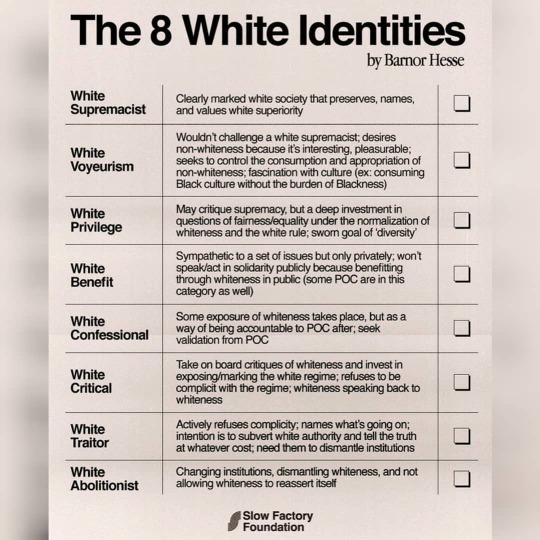
Saw this on #linkedin about whiteness and how we can all shore up the status quo unthinkingly. Valuable food for thought. Will be sitting with this and thinking about it going forwards. The 8 White Identities by Barnor Hesse White Supremacist: Clearly marked white society that preserves, names, and values white superiority White Voyeurism: Wouldn't challenge a white supremacist; desires non-whiteness because it's interesting, pleasurable; seeks to control the consumption and appropriation of non-whiteness; fascination with culture (ex: consuming Black culture without the burden of Blackness) White Privilege: May critique supremacy, but a deep investment in questions of fairness/equality under the normalization of whiteness and the white rule; Sworn goal of 'diversity' White Benefit: Sympathetic to a set of issues but only privately; won't speak/act in solidarity publicly because benefitting through whiteness in public (some POC are in this category as well) White Confessional: Some exposure of whiteness takes place, but as a way of being accountable to POC after; seek validation from POC White Critical: Take on board critiques of whiteness and invest in exposing/marking the white regime; refuses to be complicit with the regime; whiteness speaking back to whiteness White Traitor: Actively refuses complicity; names what's going on; intention is to subvert white authority and tell the truth at whatever cost; need them to dismantle institutions White Abolitionist: Changing institutions, dismantling whiteness, and not allowing whiteness to reassert itself Via Slow Factory Foundation #Bang2write #Bang2writers #amwriting #writer #author #authors #screenwriting #screenplay #novelist #screenwriters #book #novels #writersnetwork #writerscommunity #writingcommunity #writersofinstagram #writing #authorsofinstagram #writersofig #authorsofig #insta #instalike #instagood #diversity #racism #diversityandinclusion #BLM #blacklivesmatter https://www.instagram.com/p/CJ0xyYNhJf9/?igshid=1e63tqzw7qy5g
#linkedin#bang2write#bang2writers#amwriting#writer#author#authors#screenwriting#screenplay#novelist#screenwriters#book#novels#writersnetwork#writerscommunity#writingcommunity#writersofinstagram#writing#authorsofinstagram#writersofig#authorsofig#insta#instalike#instagood#diversity#racism#diversityandinclusion#blm#blacklivesmatter
0 notes
Photo

#Repost @theslowfactory @download.ins --- Re-introducing The 8 White Identities by Barnor Hesse. "There is a regime of whiteness, and there are action-oriented white identities." Hesse breaks these down from White Supremacist to White Abolitionist. This is also a helpful guide to identify where those around you (and you) truly stand. Let's be clear on a few things: 1. The people we saw at the Capitol were for the most part between White Privilege and White Supremacists. 2. White Abolitionist does not mean abolishing white people — we've heard this comment — it's about abolishing the structures that uphold unfair advantages afforded to white people at the expense of everyone else. Hesse is an Associate Professor of African American Studies, Political Science and Sociology at Northwestern University, you can follow him on Twitter @barnor_hesse #barnorhesse ID in comments (at Richmond, Virginia) https://www.instagram.com/p/CJzUPjIl-GB/?igshid=1ul9izwplok0o
0 notes
Photo
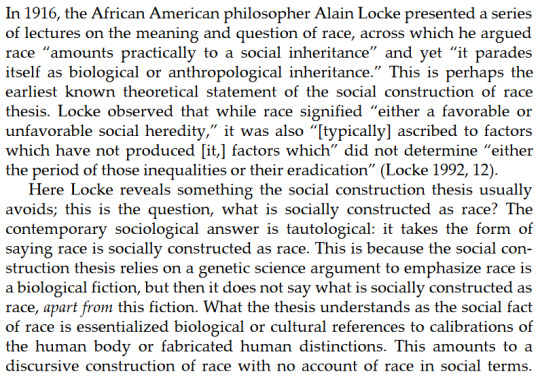
Conceptual Aphasia in Black (2016), preface by Barnor Hesse
19 notes
·
View notes
Link
Daniel Jiménez, cigano de 37 anos, foi parado pola policía, detido e conducido sob custodia policial á comisaría de Alxeciras. Foi achado morto no calabouzo. A versión policial di que Daniel se enforcou. Mais antes chamara os pais para lles dicir que estaba ben.
En Minneapolis, un home afro-americano é asfixiado até a morte baixo o xeonllo dun policía branco, case nove minutos de agonía son filmados, nove minutos en que pede por favor que o deixen respirar. Que o están matando. O funesto episodio pon todo a mexer, e millóns de persoas saen ás rúas para pedir xustiza, a asegurarse de que o seu nome, George Floyd, non sexa esquecido.
Protestos que percorren os EUA dunha punta a outra, pondo en xeque o sistema de dominación racial, numerosas agresións policiais son filmadas e divulgadas na sociedade da imaxe. As redes son alagadas dun fondo a negro como foto de perfil, en homenaxe a George Floyd. Estrelas de cinema, académicos e persoas influentes mostran o seu apoio público aos protestos e á condena ao racismo institucional, á brutalidade policial.
A Casa Branca é rodeada por manifestantes, ten de apagar as luces durante a noite por primeira vez na súa historia; o persoal de seguranza conduce o presidente Donald Trump a un búnker contiguo, moi ben protexido polo que poda acontecer, entretanto el twittea como un tolo os seus delirios racistas coa conivencia do resto da ultradereita internacional.
Como o protesto xa é global, todo político que non quer ser ‘metido no mesmo saco’ xunto co vilipendiado Trump, afánase en saír á palestra apoiando os protestos estadunidenses, evitando criticar as políticas racistas que o Estado aplica, tan visibeis nas marcas que os seus corpos de seguranza provocan nas vidas das persoas racializadas.
Os protestos teñen un punto en común, a hipocrisía que mostra unha sociedade á que é fácil conmoverse pola morte de George Floyd, a un océano de distancia, mais é capaz de anunciar que no Reino de España non hai racismo, e que as súas graves consecuencias son produto da aporofobia ou a falta de educación. É sinxelo pronunciarse así cando non sofres racismo, en troca cando instintivamente comezas a tremer ao ver o azul das luces policiais, iso xa é fariña doutra moiñada.
Falar sobre a brutalidade e a violencia policial, para calquera persoa cigana, é unha tarefa ardua, porque non é algo abstracto, senón algo que o sentimos nos nosos corpos, é algo que se manifesta na nosa vida diaria
E é que falar sobre a brutalidade e a violencia policial, para calquera persoa cigana, é unha tarefa ardua, porque non é algo abstracto, senón algo que o sentimos nos nosos corpos, é algo que se manifesta na nosa vida diaria, que afecta as nosas propias familias e, mesmo acaba coas nosas vidas. No momento en que un policía nos para pola rúa, nos revista, agride, insulta e mesmo mata, os kalos non representamos para eles máis nada que un risco. Somos un corpo de risco -o corpo racializado que teñen que ser controlado, disciplinado, ‘educado’, contido e/ou eliminado antes de ‘infectar’ a sacralizada vida social branca.
Daniel Jiménez, cigano de 37 anos foi parado, detido e transferido sob custodia policial á a comisaría de Alxeciras. Despois foi achado morto no calabouzo. A versión policial di que Daniel se enforcou. Mais chamara os pais para lles dicir que estaba ben e que sairía na mesma segunda-feira.
Nesa mesma comisaría no mes de febreiro tamén foi achado o corpo sen vida de Imad Eraffali, marroquino de 23 anos como informa El Faro de Ceuta. Mesma alegación policial, ‘suicidio’ por enforcamento cun trozo de manta.
En 2018 a familia de Manuel Fernández, cigano, recibe unha chamada desde a prisión de Albocàsser (Castelló), o fillo de 28 anos foi achado morto na cela de isolamento. ‘Morte súbita’ alegaron os funcionarios de prisións; os familiares apesar da férrea resistencia con que toparon, conseguiron ver o corpo sen vida de Manuel… cheo de marcas de arrañóns, co nariz partido, pulsos e nocellos con contusións, uñas rotas…
No cárcere de Zuera (Zaragoza), Pedro Antonio Calahorra Hernández, cigano, de 21 anos, é recluído nunha cela de isolamento en que, lembremos, non poden entrar cordóns ou outros obxectos potencialmente lesivos. Falou coa avoa apenas dous días antes da terríbel noticia. Foi achado morto, segundo declaran as autoridades competentes, esganado co cabo do televisor. Outro ‘suicidio’.
Miguel Ángel Fernández, cigano, foi detido en Zaragoza, e retido nos calabouzos da comisaría do corpo nacional de policía. Desde fixo un traxecto durante o cal lle foi administrado un enorme cóctel de psicofármacos, entre eles metadona, apesar de non ser drogo-dependente. Segundo o atestado policial morreu por ‘morte súbita’. No atestado non son mencionados os avisos dos compañeiros de cela que alertaron da falta de respiración, nin os quince minutos de gravación ‘extraviados’ correspondentes á detención de Miguel. Apesar das denuncias, o xuíz ditou arquivamento da causa.
A cara máis crúa do anticiganismo, o mecanismo de represión por antonomasia usado polo poder payo para subordinar, ‘civilizar’ e mesmo eliminar o pobo romaní, foron e son as forzas de ‘seguranza’ do estado
É evidente que os mecanismos de represión dese sistema de dominación ao que chamamos anticiganismo teñen moitas caras, mais a máis crúa, o mecanismo de represión por excelencia usado polo poder payo para subordinar, ‘civilizar’ e mesmo eliminar o pobo romaní, foron e son as forzas de ‘seguranza’ do estado, que xunto co sistema xudicial e o penal, aseguran que o sistema racial continúa a funcionar á perfección.
O encarceramento masivo de persoas ciganas é unha realidade no Estado español, como xa apuntou a principios do ano 2000 o proxecto ‘Barañí’ nun estudo acerca das mulleres ciganas encarceradas. As cifras son arrepiantes: sendo oficialmente ao redor do 1,7% da poboación española total, nos cárceres representan o 25% das reclusas. Aínda cando no caso da violencia policial anticigana existe un claro viés de xénero, xa que o obxectivo principal dos ataques costuman ser homes novos, infelizmente este tema non parece chamar a atención das investigacións e a axenda académica dominante neste tipo de estudos.
A construción do imaxinario colectivo cigano-carcerario, cun punto álxido nos finais dos anos setenta e oitenta no cinema kinki, xunto co éxito musical de grupos ciganos con letras duras sobre cárceres e marxinalización, non só achan resposta real en como éramos tratados por aquela sociedade que despectivamente chaman a ‘España cañí’, senón que son un fiel reflexo das vivencias que en bairros ‘gueto’, viven as comunidades romanís hoxe. Así é como este nefasto sistema racista continúa a nos asediar, vixiar, encarcerar e asasinar coa complicidade da sociedade civil, pois no seu imaxinario colectivo é o que merecemos.
Aquel reflexo hoxe convertido en cultura ‘pop’ da marxinalización cigana nos anos setenta, é a mesma construción que a lóxica da modernidade Europea construíu sobre nós e sobre musulmáns, negros e indíxenas. É o deshumanizado relato de seres irracionais e perigosos que non chegan á categoría de ser humano e portanto, non son dignos de ser tratados como tal. Sendo o principio que fundamenta as nosas relacións co Estado, a violencia e o control.
Os serios obstáculos para a denuncia e o pesimismo máis absoluto que rexe a nosa relación cos poderes provoca que non denunciemos sequer as máis selvaxes agresións contra nós
Por un lado, o medo que xera a perpetua violencia á que somos sometidos, a perpetua desconfianza nas institucións, os serios obstáculos para a denuncia e o pesimismo máis absoluto que rexe a nosa relación cos poderes provoca que non denunciemos incluso as máis selvaxes agresións contra nós.
Por outra, a ignorancia mediática ou o tratamento racista do racismo anticigano incentiva a non visibilización e a estigmatización social dos nosos problemas. Caricaturizados como criminais, todo o relato mediático tende apuntar a iso, vímolo moi claro con Manuel Fernández no programa de Ana Rosa, quen foi vítima dun tiro na cabeza disparado por un veciño payo. Por estar perto do seu horto, ao pensar o ‘amábel xubilado’, en palabras do propio programa, que ía roubarlle catro fabas.
A usurpación do espazo político romaní e o rexeitamento sistemático a ser recoñecidos como un suxeito político autónomo en igualdade co resto de autonomías que compoñen o Estado español, alén da negación da nosa identidade nos tratamentos informativos e oficiais, fai que sexa case imposíbel realizar un rexistro de vítimas fidedigno. Portanto, é moi complicado demostrar con datos á Administración a desproporcionalidade en detencións de persoas ciganas, do seu encarceramento e mesmo da súa morte sob custodia policial.
A brutalidade policial é a punta do iceberg, a cara máis visíbel dun sistema de dominación racista que revela o arraigamento da sociedade actual no pasado xenocida que se nega a confrontar; un reflexo palpábel da supremacía branca e a súa profunda imbricación nas narrativas e aspiracións políticas do Estado mesmo e as súas institucións.
Hoxe vemos como cidades do mundo enteiro se levantan en protesto, vemos como a mesma sociedade que erixiu con orgullo estatuas a recoñecidos escravaxistas ou xenocidas agora as derruba. Ao tornar a ollada á sociedade en que vivimos, surxe a dúbida de se España será capaz de derrubar as estatuas de Colón, de queimar as ‘xestas heroicas’ de Nuñez de Balboa ou de borrar do rueiro e a memoria colectiva o infame Marqués de la Ensenada. Será ese momento que tanto desexamos un atrevido acto que se limite a derrubar a evidente violencia ‘simbólica’ que eses monumentos exercen, ou chegaremos a ser capaces de, como apunta Barnor Hesse, cuestionar o por que as súas historias foron normalizadas e convertidas en heroicidades, en símbolos patrios.
No actual escenario político só nos resta preguntarnos unha cousa, será capaz a sociedade española de aceptar a responsabilidade política de arrancar con vergoña, arrepentimento e coherencia esa páxina da súa historia que condiciona o presente dos racializados deste país?
Por Daniel Jiménez
Por Manuel Fernández
Por Pedro Antonio Calahorra
Por Miguel Anxo Fernández
Por Ilías Tahiri
Por Mohammed Bouderbala
Por Mame Mbaye
Por George Floyd
Por Lucrecia Pérez
Por todos os nosos mortos, faremos que pase.
* Kale Amenge (Ciganos polos nosos) é unha organización política romaní independente que traballa pola emancipación colectiva do pobo Roma e a construción de autonomía política cigana www.kaleamenge.org
0 notes
Text
RT @CmsReorient: Macron's just another example of what Barnor Hesse @barnor_hesse has described as white amnesia. The funny thing is he is supposed to be very smart having been thru the finest education system that France provides- which shows why it is important to decolonize the curriculum! https://t.co/g3PwhHSlou
Macron's just another example of what Barnor Hesse @barnor_hesse has described as white amnesia. The funny thing is he is supposed to be very smart having been thru the finest education system that France provides- which shows why it is important to decolonize the curriculum! https://t.co/g3PwhHSlou
— CMS ReOrient (@CmsReorient) July 8, 2018
0 notes
Text
Gabrielle Union: “I think the floodgates have opened for white women. I don’t think it’s a coincidence whose pain has been taken seriously. Whose pain we have showed historically and continued to show” https://t.co/7JcFS94SbR
— Barnor Hesse (@barnor_hesse) December 23, 2017
via @Dloz_Lami
December 24, 2017 at 09:42AM
0 notes